
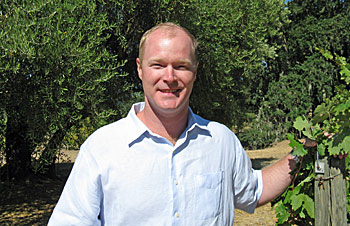
Kirk Venge makes highly praised wine for his own winery as well as numerous other Napa Valley wineries.
Kirk Venge: The further rising
of a rising superstar winemaker
He takes on over 120 different lots of wine. All in a day's work...er, "fun."
by
Alan Goldfarb
September 30, 2008
 irk Venge has just gotten back from a visit to yet another Napa Valley vineyard, of which he says, “I was kicking the ground a little bit.” That’s because pawing at the soil, picking it up in his hands, and swiping the earth with his big scuffed boots, is what Venge does.
irk Venge has just gotten back from a visit to yet another Napa Valley vineyard, of which he says, “I was kicking the ground a little bit.” That’s because pawing at the soil, picking it up in his hands, and swiping the earth with his big scuffed boots, is what Venge does.
He may be a second-generation superstar-on-the-rise winemaker, but it’s in the vineyards - like so many astute men and women before him - that winemaking begins. That notion has been written about and spoken about ad nauseam. But for Venge, despite the revving buzz about his wines, it is as true as the thinning and tousled blond hair on his head.
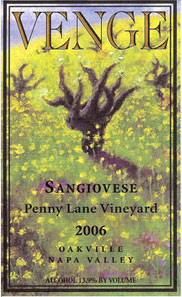 “I like to get a feeling of the vineyard before I say yes.” Meaning: he has to learn a vineyard’s quirks before he will purchase fruit from it for his clients - which today amounts to nine and counting - and for his own brand, Venge Vineyards. “I also like to know who’s bought the fruit before. There’s so much at risk if you go blindly into a piece and end up not as excited as you’d like to be. Also, fruit prices are so high… Experience shows you the difference in (various) places. If I walked into a vineyard site on a hillside versus the valley floor, I look at the consistency, how the vines are oriented, if there are eucalyptus trees.”
“I like to get a feeling of the vineyard before I say yes.” Meaning: he has to learn a vineyard’s quirks before he will purchase fruit from it for his clients - which today amounts to nine and counting - and for his own brand, Venge Vineyards. “I also like to know who’s bought the fruit before. There’s so much at risk if you go blindly into a piece and end up not as excited as you’d like to be. Also, fruit prices are so high… Experience shows you the difference in (various) places. If I walked into a vineyard site on a hillside versus the valley floor, I look at the consistency, how the vines are oriented, if there are eucalyptus trees.”
Venge, 32 and as tall as a vine at its zenith, grew up on a tractor, his dad Nils’ tractor. It was his father, himself a highly regarded consulting winemaker and the owner of Saddleback Cellars in Oakville, who, sure enough, taught his son most everything he knows.
“That’s where I understood viticulture,” Venge the younger says. “He taught me a hands-off approach. My style might be a little riper and his style is a little more rustic. And he taught me about not fining, and about time in oak. But we have little differences. I’m not saying one’s better than the other, but some of it has to do with handling of fruit. If one of my clients wants ripe fruit, I’ll leave it out there to hang. … I’ll think of them first and then take care of myself on the back end.”
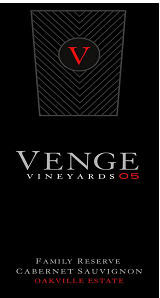 Venge, who describes himself as a “humble” man, one who is “well-grounded” and “a good person”, has not relied solely upon his father for teaching him about winemaking acumen. He also counts observing the likes of Dave Ramey (Ramey Cellars), Philippe Melka (über-consultant), Craig McLean (Juslyn, Ahnfeldt, Brookdale), and the classicist Ric Forman (Forman Vineyards). But it’s his dad, who once received a perfect score for one of his wines, to whom he seems to hold the most reverence. “He farms Saddleback himself and that’s what I do on my new ranch.”
Venge, who describes himself as a “humble” man, one who is “well-grounded” and “a good person”, has not relied solely upon his father for teaching him about winemaking acumen. He also counts observing the likes of Dave Ramey (Ramey Cellars), Philippe Melka (über-consultant), Craig McLean (Juslyn, Ahnfeldt, Brookdale), and the classicist Ric Forman (Forman Vineyards). But it’s his dad, who once received a perfect score for one of his wines, to whom he seems to hold the most reverence. “He farms Saddleback himself and that’s what I do on my new ranch.”
That new ranch is an 11-acre site that he recently bought with his mom and sister after a divorce-in-process settlement between his parents forced the sale of the family’s 17-acre site, Rossini Vineyards near Howell Mountain. As is often the case in these matters, Kirk was left out of the loop, which caused him to feel as though he were a man without a vineyard, which he was.
“This all happened without me knowing. I’m a grape grower and I don’t feel right making wines without my own vines,” he explains. “I loved that ranch, and hated to see it go. It was a heartbreaking experience. (So) it was time to see what else was out there, and not to miss the harvest. I love growing grapes, most importantly from your own vineyard. That’s the most beautiful thing about it. That’s where I grew up, riding the tractor with my dad.”
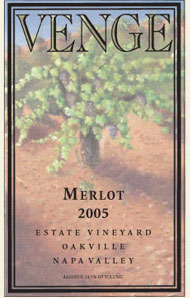 Thus, in short order, he took part of the $11.5 million proceeds from Rossini to put it into the Calistoga site, purchased for $3.3 million, in a high-profile neighborhood that includes Araujo’s Eisele Vineyard, the Fisher Lamb Vineyard, and the old Frediani Vineyard. The Cabernet from the Calistoga vineyard has been going to Ramey for his reserve wines.
Thus, in short order, he took part of the $11.5 million proceeds from Rossini to put it into the Calistoga site, purchased for $3.3 million, in a high-profile neighborhood that includes Araujo’s Eisele Vineyard, the Fisher Lamb Vineyard, and the old Frediani Vineyard. The Cabernet from the Calistoga vineyard has been going to Ramey for his reserve wines.
“It has potential. I tried the wines that Ramey made (from there) and I know the neighborhood,” he says. “I would love to develop the ranch. But I’ve got to find more water. We start drilling on Tuesday (with the famous Napa Valley water witcher Laurie Wood).
The vineyard, planted in 1990, is flat but comes off the hill where the Calistoga palisades sweep up. The light soils are comprised of gravelly, silt-y tuft and are not very vigorous. “I have to learn about the tannin of the vineyard, what’s the color of the wine. This will be a learning year,” he surmises.
He’s making wine for some very small labels that include B Cellars, Macauley, Honeycutt, Jax, Igneous, Bacio Divino, Calistoga Ranch (the resort), JR Wine, and Trespass. For a couple of them, he uses the famed To Kalon Vineyard in Oakville, the parcel owned by grower Andy Beckstoffer. Venge calls To Kalon, whose grapes are most likely the costliest in

Kirk is making wine for some very small labels that include B Cellars, Macauley, Honeycutt, Jax, Igneous, Bacio Divino, Calistoga Ranch (the resort), JR Wine, and Trespass.
He makes a couple of different wines from To Kalon, but they all are different, depending upon the needs of the client, which includes the style, where they are made, and where they are stored. He calls this, “winery terroir”.
“There’s so much winery terroir,” he says of the phenomenon. “There are evaporative losses in different locations, which manifest in water or alcohol retention in the barrels. In caves and other surrounding atmospheres, there’s the smell. Bacio and Macauley are picked from the same rows (from To Kalon) and picked on the same day. Bacio Divino is aged down in Trefethen and crushed at Miner and those wines turn out quite differently (from the Macauley).
“Also, topping-wine lots (used to top off a barrel) make the difference, too. There’s also different equipment, and water (sources) make a difference, too.” It all adds up to “winery terroir”, resulting in different wines made with the same fruit.
Playing in the Napa Valley, with such highly prized fruit, making some wine that has caught the attention of others, as well as coming from a well-known winemaking father, does Kirk Venge realize that he’s on the precipice of achieving elite status?
“No. I don’t think of it like that. I just put my nose to the grindstone and keep working,” is the way he characterizes it. “My father is a good winemaker but I try
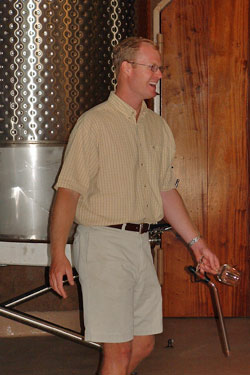
TASTE TEST: Kirk Venge in pursuit of excellence at his winery’s new Napa Valley location in Calistoga.










 READER FEEDBACK: To post your comments on this story,
READER FEEDBACK: To post your comments on this story,




